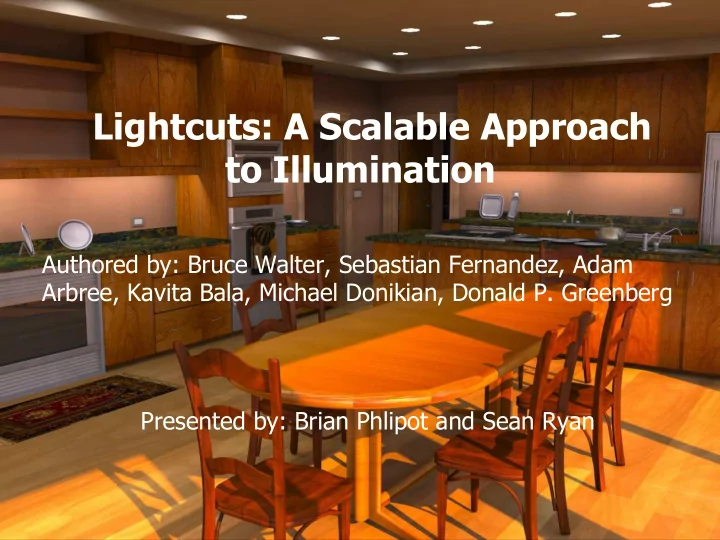

Lightcuts: A Scalable Approach to Illumination Authored by: Bruce Walter, Sebastian Fernandez, Adam Arbree, Kavita Bala, Michael Donikian, Donald P. Greenberg Presented by: Brian Phlipot and Sean Ryan
Outline • Introduction o What is Lightcuts and why do we need it? • Light Tree o How to cluster lights o How to make a lightcut • Implementation o Calculating error bounds o Converting to point lights • Results
Lots of Lights!
Why do we want Lightcuts? • Direct illumination is linear in number of lights • Lightcuts estimates clusters of lights
Useful with few lights too! • Represent complex lighting with many lights. o Environment map as a sphere of directional lights. o Divide area lights into grids of oriented lights. • Instant Radiosity o Simulates indirect illumination as direct illumination o Flood the scene with rays, place virtual point lights (VPLs) where they hit surfaces All of this will be explained in detail later...
Aside: Supported Point Lights • Omni: equally in all directions. o e.g. Spherical lights • Oriented: lobe based emission. o e.g. Area lights, indirect lights • Directional: fixed direction o e.g. Env maps, sun/sky
How do we Cluster? • Clustering Criterion o Only cluster lights of the same type. o Similar positions and orientations. • Forming a Cluster o Randomly pick representative light. o Boost its radiance to the sum of all constituents.
The Light Tree • Hierarchy of lights and clusters. • Computed once per image. • Each sample ray makes its own "lightcut". Clusters Individual Lights
Making Cuts • Maintain a set of included nodes. • Start at the root node. • While the error in a node is >2% o Replace that node with its two children. • We get a partition of the set of lights.
Three Example Cuts
Calculating Error Bounds • We must consider the three outside terms. Visibility (V i ): • In the range [0, 1]. • Hard to bound when dealing with semitransparent surfaces. • Just say it's always 1.
The Geometric Term (G i ) • Variables: o y i : location of point light. o x: where we are computing illumination. o phi: angle between viewing vector and vector of greatest emission. • Directional lights are trivial. • Omni lights are bounded by min distance.
Bounding Oriented Lights • Want to minimize the angle phi. • Translate all (x, y) pairs such that each y is at the origin. Area of lights => area of points. • Find angle to new bounding volume and subtract angle of orientation bounding cone. • Get distance term like we did for Omni lights.
The Material Term (M i ) • Product of the BSDF and cosine factor. • Already know how to bound a cosine. • BSDF Bounds: o Lambertian: constant value. o Phong: depends on cosine of reflection angle. o Ward: asymmetric, depends on half-angle. See (Walter 2005) for a bounding algorithm.
Converting to Point Lights • Area Lights o Pick uniformly distributed point lights • Env Maps o Pick with respect to intensity [Agarwal et al. 2003] o Threshold the map into levels of constant radiance o Spread points throughout each level.
Indirect Illumination • Instant Radiosity [Keller et al. 1997] o Shoot random rays from lights into the scene. o Create VPLs at scatter points. • 1,000-1,000,000 VPLs => use full BRDF • Clamp individual VPLs to reduce noise • Supports glossy surfaces but not caustics.
Lightcuts (128s) Reference (1096s) Error Error x16 Kitchen: 338K polygons, 4608 lights (72 area sources)
Temple: 2.1M polygons, 505,064 lights, 225 seconds
Video
¿Questions?
References • Lightcuts o http://www.cs.cornell.edu/~kb/projects/lightcuts/ • Structured Importance Sampling of Env Maps o http://www.cs.berkeley.edu/~ravir/papers/structured/ • Instant Radiosity o http://dl.acm.org/citation.cfm?id=258769
Recommend
More recommend